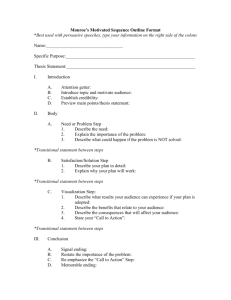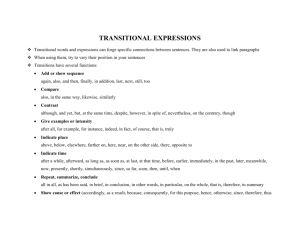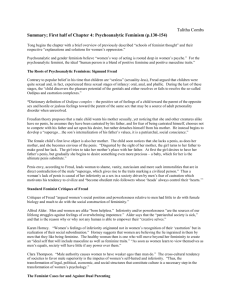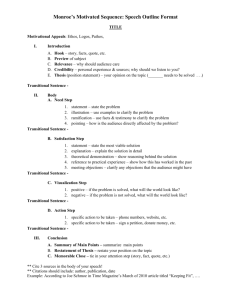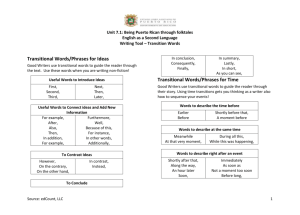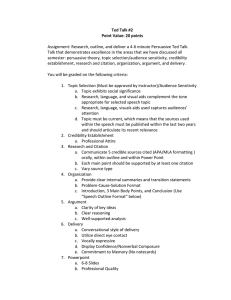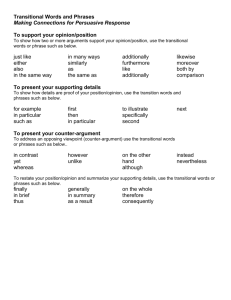Fetishism and Transitional Object
advertisement
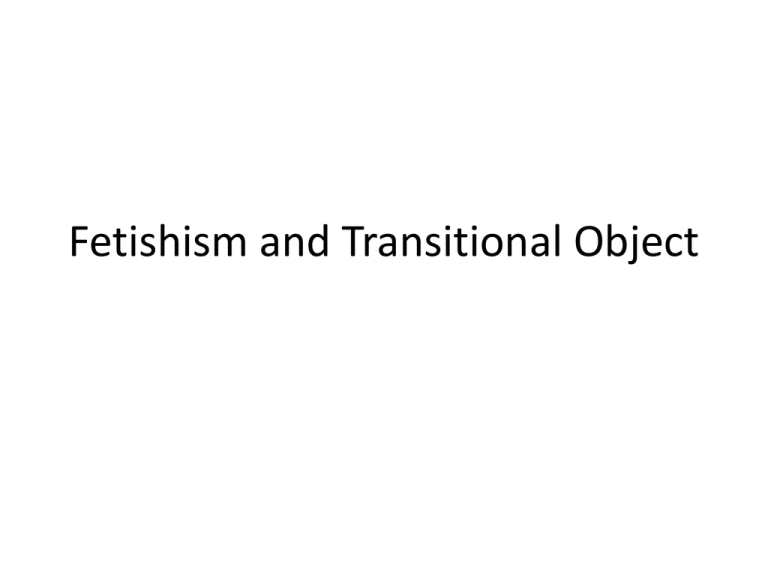
Fetishism and Transitional Object Outline • • • • • • • • Freud’s Fetishism What is a fetish? Fear of Castration narcissism Substitute for the penis Transitional Object Transitional Character of Religious Art Transitional Character of the Material of Art Lacan and the Power of the Gaze What is a fetish? • It revealed itself so naturally • The fetish is a substitute for the penis . . . But for a particular and quite special penis that had been extremely important in early childhood but had later been lost ( Freud 953). • The fetish is precisely designed to preserve [a special penis] from extinction (953). • the woman’s (the mother’s) penis that the little boy once believed in and does not want to give up. Fear of Castration narcissism • If a woman had been castrated, then his own possession of a penis was in danger. narcissism, attached to that particular organ. • Laforgue would say. . . • The boy “scotomizes” his perception of the woman’s lack of a penis ( Freud 953). • to form a mental blind spot about. • But, Freud does not think the perception is totally wiped out. (it has persisted) Substitute for the penis • A reached compromise of the conflict: under the dominance of the unconscious laws of thought in his mind, the woman has got a penis, but this penis is no longer the same as it was before (Freud 954). • something else has taken its place, has been appointed its substitute. • Set up a memorial to itself in the creation of this substitute. Other examples • • • • (Freud 954-955) Stopping memory in traumatic amnesia Failed cognizance of death (a piece of reality is disavowed by the ego, just as the castration of women is disavowed in fetishists.) • Two current: (situation bet. Two assumptions) • -in mental life, father’s death is not recognized • -another current, took full account of the fact • Subtle instance: both the disavowed and the affirmation of the castration • Affection and hostility in the treatment of the fetish—which run parallel with the disavowed and the acknowledgement of the castration— are mixed in unequal proportions in different cases, so that the one or the other is more clearly recognized (Freud 956). • “the woman has still got a penis” and “my father has castrated the woman” Transitional Object • A special object (teddy bear, blanket) • Purpose of symbolization—separation from mother, absence of mother • A part of ego/ self • Ex: Linus experiences the anxiety of an assault on his ego, when he is separated from the blanket. Transitional Character of Religious Art • Gods are up (in the sky or mountaintop)— Transitional architecture to relate people with their gods ( Adams 201). • The Mesopotamian ziggurates • The Egyptian pyramids • The Gothic cathedrals • Literally rise toward God and the heavens • Visual reminders of another level of existence The Mesopotamian ziggurates www.golde...ct.org.uk/ 206ziggurat.html The Egyptian pyramids www.britsincancun.com/vaccines.html • Exterior architecture interior image of god • Temples and churches express the transition between material, exterior world of the worshiper and the interior sanctuary housing an image of god. • The architectural “journey” from exterior to interior replicates the child’s developmental “journey” from interior to exterior, from the mother’s body to the outside world • ( Adams 202). life and death • • • • Death masks and portraiture Presence and absence of mother Image real person Self-portraiture plays a special role in regard to the transitional object. In the case of a straightforward self-portrait, the artist seems to be communicating directly with the audience, bridging the gap between artist and viewers ( Adams 204). The Transitional Character of the Material of Art • “Formation” and becoming through forming is a part of the transitional character of art. • Artist’s idea—natural materials (transitional character)—artist’s product. • The transitional is like a bridge: • ideas images Lacan and the Power of the Gaze • “desire” is the instinct aroused by a gap, or a perceived absence—by something not seen ( Adams 207). • The fort/da game is predicated on child’s perception of mother’s absence / presence (207). • Mirror phase • Desire is from permanent “lack” (losing the sense of totality) • Child’s castration anxiety is the result of a “lack,” or an absence. • Lacan’s theoretical emphasis on what is seen and not seen, what is present and absent, informs his related concepts of the “gaze” and “desire.” The gaze rivets the subject to something that is present, whereas desire is the instinct for what is absent (208). • “gaze” should be present • (the imaginary of perception: expression of the condition and the linguistic structure of the symbolic.) Works Cited Freud, Sigmund. “Fetishism.” The Norton Anthology of Literary Theories and Criticism. Eds. Vincent Leitch, William Cain, Laurie Anne Finke, and Barbara Johnson. New York: Norton, 2001. 952-956. Print. Adams, Laurie Schneider. “Psychoanalysis II: Winnicott and Lacan.” The Methodologies of Art: An Introduction. New York: HarperCollins, 1996. 200210. Print.

